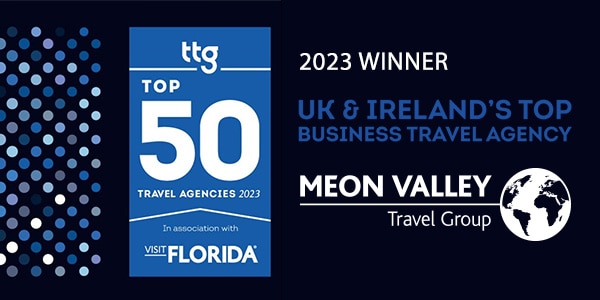In the first of our ‘5 minutes with’ posts, we hear from Chris Lewis the Founder & CEO of Travelogix, our travel management data and reporting partner.
1. Why did you start Travelogix?

Since I was a kid, I had always wanted to be my own boss, so I suppose it has always been an ambition for me to start my own company.
The only industry I have known is Travel, and more specifically travel technology, so I suppose I was always looking for opportunities. But, Travelogix was formed when the term “big data” was just being thrown around, though I’m not convinced anyone really knew what it meant at the time.
There was a big focus on data on the horizon and people were starting to see the value that data held. We realised, at that time, that there was a massive disconnect between the systems holding the data for TMCs and how it was being delivered to the end customer.
At the time, data was being pumped out of the mid/back-office system into static spreadsheets or PDFs from bolt-on systems that were often built as an afterthought to the product they were pulling data from. This made the reporting process time consuming and clunky and meant that account managers would have the task of analysing and compiling that data into meaningful insights for the customer.
This had a number of issues, primarily; as soon as the data was exported from the mid/back office or booking system it was out of date. If there was a booking in that data that had an amendment made against it, it was never updated in the dataset sent to the account manager, hence the client didn’t see that update until the next reporting cycle.
The second issue was that each account manager would be responsible for presenting the data to the client, meaning that each account manager could present or analyse it differently to the next which resulted in a lack of consistency across the reporting element of a TMC. More importantly, human error occurred meaning that the data could never truly be trusted.
Finally, all of this data would have either come from one source, often the mid/back office, or from multiple sources which took time to extract, combine and analyse.
Our ambition was to eradicate manual processing, manual compilation and errors by completely automating the collection and normalisation of data from multiple systems in real time, and making that data accessible on demand and in a consistent format so that the travel manager didn’t have to wait for the end of each reporting period to see what had happened. They could simply access their data via an intuitive online platform whenever they wanted to see a live “state-of-play”.
We delivered that solution in 2013 and Meon Valley Business Travel was the first TMC to launch our product and we take great pride in the fact that we are still working together eight years later.
2. What changes have you seen in Travel Management Technology in the past 18 months?
The past 18 months have obviously been terribly tough for everyone involved in the travel industry and Travelogix, along with our peers, have done a lot to help our customers. The general view is that we need to offer as much support as we can afford now to ensure there is a client base there to serve at the end of all this. We have done this by staying in close communication with our clients and partners, running various product events and developing real-time Covid tracking tools that we have made available to all of our clients free of charge. A lot of our peers have done similar things which I think says a great deal about the relationships we all have within the industry and the value we put on them.
More generally, we are seeing a lot more in terms of personalisation in business travel alongside the hot topics of sustainability, duty of care and on-trip communication; all of which we are focussed on at Travelogix. We have some very exciting developments on those fronts coming up very soon, some of which Meon Valley Business Travel will be at the forefront of, so watch this space.

3. How have you seen Travel Management Companies using data during the pandemic to support their clients?
Absolutely, as I mentioned; we have developed a Covid-19 data tracker which has been widely used by Travel Management Companies, and we have partnered with the Business Travel Association (BTA) to provide weekly stats relating to the impact that travel restrictions are having on National Gross Domestic Product (GDP) which is going a long way to helping their government lobbying efforts.
We have also seen our clients proactively using data from our platforms to plan for recovery – analysing the number of active agents, the transactions being handled, margins and booking touch rates to determine when consultants need to be returned from furlough to help with enquiry demand.

4. How do Travel Managers maximise the value of Travel Management Data and insight? What are your top tips?
There are three things, firstly know your objective, secondly “be in” your data, and thirdly make small adjustments as required.
To the first point, there is no value in data unless you have a goal or objective that you are trying to achieve or track, otherwise you’re just looking at numbers on a screen that have no meaning.
Whether your goal is cost reduction, traveller welfare improvement or improved sustainability – define those goals and what you need to do to achieve that goal.
If you know what your goals are but don’t know how to achieve them, ask your TMC’s account manager, they understand your travel programme, what can be done to affect change and that’s the value they bring.
Once you know what you want to achieve and how you are planning to achieve it; “be-in” your data and set daily or weekly goals. Knowing what metrics need to change in which direction, whether that is advanced purchase trends, less premium cabin travel or reduced CO2, be aware of your numbers. Watch those figures on your dashboard and compare them to previous periods to make sure they are going in the right direction.
If they aren’t make small changes that you can track and analyse to determine what works.
5. How do you see Travel Management Data and insight impacting travel programmes post-pandemic?
I think there will be more of a focus on permissible and justified travel. I think the days of day trips for single meetings are gone, those sorts of trips will be few and far between and will need to be tied in with other meetings or objectives.
In line with that expectation, we are planning to capture more data from sooner in the booking flow relating to things like reasons for travel, and more, as we expand our platforms to offer features such as itinerary tracking, itinerary management and pre-trip approvals. Like I say, lots of exciting stuff to come that will keep our products and the service of our clients relevant to their customers in a post-Covid world, so watch this space.
6. What is the strangest report that you have been asked to supply?
I do remember a conversation with one of our clients who wanted us to work out the average age of passengers next to whom their travellers had sat next to. The TMC in question had received complaints from a Travel Manager who said that one of their senior travellers was convinced that there was an agenda to sit him/her next to children on flights despite making it clear that he/she was not to be sat next to children.
It was even more surprising that when we delved a little deeper, we realised that the customer in question was a well-known nursery brand.
That is one of the few reporting requests we could not fulfil I’m afraid.
Find out more about how Travelogix can bring actionable data and insight to help drive your travel programme or book a demo here.

Julian Munsey – Sales Director
Connect: LinkedIn
Email: [email protected]
Sign up for the Meon Valley Travel Update a monthly update of changes in Business Travel both global and domestic.






